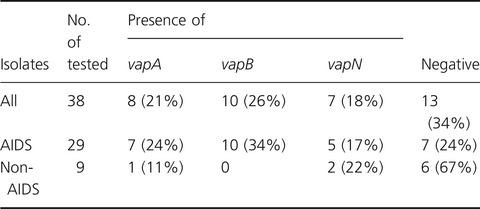当前位置:
X-MOL 学术
›
Lett. Appl. Microbiol.
›
论文详情
Our official English website, www.x-mol.net, welcomes your feedback! (Note: you will need to create a separate account there.)
Reinvestigation of the virulence of Rhodococcus equi isolates from patients with and without AIDS
Letters in Applied Microbiology ( IF 2.4 ) Pub Date : 2020-10-02 , DOI: 10.1111/lam.13386 S Takai 1 , N Sawada 1 , Y Nakayama 1 , S Ishizuka 1 , R Nakagawa 1 , G Kawashima 1 , N Sangkanjanavanich 1, 2 , Y Sasaki 1 , T Kakuda 1 , Y Suzuki 1
Letters in Applied Microbiology ( IF 2.4 ) Pub Date : 2020-10-02 , DOI: 10.1111/lam.13386 S Takai 1 , N Sawada 1 , Y Nakayama 1 , S Ishizuka 1 , R Nakagawa 1 , G Kawashima 1 , N Sangkanjanavanich 1, 2 , Y Sasaki 1 , T Kakuda 1 , Y Suzuki 1
Affiliation

|
Rhodococcus equi emerged as a zoonotic pathogen of human immunodeficiency virus‐infected patients over the last three decades. Two virulence plasmid types of R. equi, pVAPA and pVAPB associated with equine and porcine isolates, have been recognized, and more recently, pVAPN, a novel host‐associated virulence plasmid in R. equi, was found in bovine and caprine isolates. We reinvestigated 39 previously reported isolates of R. equi from patients with and without acquired immunodeficiency syndrome (AIDS) by detecting vapA, vapB and vapN using PCR and plasmid profiling. After excluding one isolate that could not be cultured from frozen storage, eight isolates carried a virulence plasmid encoding vapA (pVAPA), 10 carried a virulence plasmid encoding vapB (pVAPB), seven carried a virulence plasmid encoding vapN (pVAPN) and 13 were negative for those genes. Of the 29 isolates from patients with AIDS, 7, 10 and 5 harboured pVAPA, pVAPB and pVAPN respectively. Among nine isolates from patients without AIDS, one and two harboured pVAPA and pVAPN respectively. This study demonstrated that pVAPN‐positive R. equi existed in human isolates before 1994 and reaffirmed that equine‐associated pVAPA‐positive, porcine‐associated pVAPB‐positive and bovine‐ or caprine‐associated pVAPN‐positive R. equi are widely spread globally. Because domestic animals might be major sources of human infection, further research is needed to reveal the prevalence of pVAPN‐positive R. equi infection in cattle and goats.
中文翻译:

重新研究从患有和未患有艾滋病的患者身上分离的马红球菌的毒力
在过去的三十年中,马红球菌成为人类免疫缺陷病毒感染患者的人畜共患病原体。与马和猪分离株相关的两种 R. equi 的毒力质粒类型 pVAPA 和 pVAPB 已被识别,最近,在牛和山羊分离株中发现了 pVAPN,一种新的宿主相关的 R. equi 毒力质粒。我们通过使用 PCR 和质粒分析检测 vapA、vapB 和 vapN,重新研究了 39 株先前报道的来自患有和未患有获得性免疫缺陷综合征 (AIDS) 的患者的马铃薯分离株。排除1个无法冷冻保存的分离株后,8个分离株携带编码vapA(pVAPA)的毒力质粒,10个携带编码vapB(pVAPB)的毒力质粒,7 人携带编码 vapN (pVAPN) 的毒力质粒,13 人对这些基因呈阴性。在来自艾滋病患者的 29 株分离物中,分别有 7、10 和 5 株含有 pVAPA、pVAPB 和 pVAPN。在来自非艾滋病患者的九个分离株中,一株和两株分别携带 pVAPA 和 pVAPN。该研究表明,1994 年之前,人类分离株中存在 pVAPN 阳性的马红毛虫,并重申了马相关的 pVAPA 阳性、猪相关的 pVAPB 阳性和牛或山羊相关的 pVAPN 阳性马红毛虫在全球范围内广泛传播。由于家畜可能是人类感染的主要来源,因此需要进一步研究以揭示牛和山羊中 pVAPN 阳性的马R.感染的流行情况。在来自非艾滋病患者的九个分离株中,一株和两株分别携带 pVAPA 和 pVAPN。该研究表明,1994 年之前,人类分离株中存在 pVAPN 阳性的马红毛虫,并重申了马相关的 pVAPA 阳性、猪相关的 pVAPB 阳性和牛或山羊相关的 pVAPN 阳性马红毛虫在全球范围内广泛传播。由于家畜可能是人类感染的主要来源,因此需要进一步研究以揭示牛和山羊中 pVAPN 阳性马R. 感染的流行情况。在来自非艾滋病患者的九个分离株中,一株和两株分别携带 pVAPA 和 pVAPN。该研究表明,1994 年之前,人类分离株中存在 pVAPN 阳性的马红毛虫,并重申了马相关的 pVAPA 阳性、猪相关的 pVAPB 阳性和牛或山羊相关的 pVAPN 阳性马红毛虫在全球范围内广泛传播。由于家畜可能是人类感染的主要来源,因此需要进一步研究以揭示牛和山羊中 pVAPN 阳性的马R.感染的流行情况。equi广泛分布于全球。由于家畜可能是人类感染的主要来源,因此需要进一步研究以揭示牛和山羊中 pVAPN 阳性的马R.感染的流行情况。equi广泛分布于全球。由于家畜可能是人类感染的主要来源,因此需要进一步研究以揭示牛和山羊中 pVAPN 阳性的马R.感染的流行情况。
更新日期:2020-10-02
中文翻译:

重新研究从患有和未患有艾滋病的患者身上分离的马红球菌的毒力
在过去的三十年中,马红球菌成为人类免疫缺陷病毒感染患者的人畜共患病原体。与马和猪分离株相关的两种 R. equi 的毒力质粒类型 pVAPA 和 pVAPB 已被识别,最近,在牛和山羊分离株中发现了 pVAPN,一种新的宿主相关的 R. equi 毒力质粒。我们通过使用 PCR 和质粒分析检测 vapA、vapB 和 vapN,重新研究了 39 株先前报道的来自患有和未患有获得性免疫缺陷综合征 (AIDS) 的患者的马铃薯分离株。排除1个无法冷冻保存的分离株后,8个分离株携带编码vapA(pVAPA)的毒力质粒,10个携带编码vapB(pVAPB)的毒力质粒,7 人携带编码 vapN (pVAPN) 的毒力质粒,13 人对这些基因呈阴性。在来自艾滋病患者的 29 株分离物中,分别有 7、10 和 5 株含有 pVAPA、pVAPB 和 pVAPN。在来自非艾滋病患者的九个分离株中,一株和两株分别携带 pVAPA 和 pVAPN。该研究表明,1994 年之前,人类分离株中存在 pVAPN 阳性的马红毛虫,并重申了马相关的 pVAPA 阳性、猪相关的 pVAPB 阳性和牛或山羊相关的 pVAPN 阳性马红毛虫在全球范围内广泛传播。由于家畜可能是人类感染的主要来源,因此需要进一步研究以揭示牛和山羊中 pVAPN 阳性的马R.感染的流行情况。在来自非艾滋病患者的九个分离株中,一株和两株分别携带 pVAPA 和 pVAPN。该研究表明,1994 年之前,人类分离株中存在 pVAPN 阳性的马红毛虫,并重申了马相关的 pVAPA 阳性、猪相关的 pVAPB 阳性和牛或山羊相关的 pVAPN 阳性马红毛虫在全球范围内广泛传播。由于家畜可能是人类感染的主要来源,因此需要进一步研究以揭示牛和山羊中 pVAPN 阳性马R. 感染的流行情况。在来自非艾滋病患者的九个分离株中,一株和两株分别携带 pVAPA 和 pVAPN。该研究表明,1994 年之前,人类分离株中存在 pVAPN 阳性的马红毛虫,并重申了马相关的 pVAPA 阳性、猪相关的 pVAPB 阳性和牛或山羊相关的 pVAPN 阳性马红毛虫在全球范围内广泛传播。由于家畜可能是人类感染的主要来源,因此需要进一步研究以揭示牛和山羊中 pVAPN 阳性的马R.感染的流行情况。equi广泛分布于全球。由于家畜可能是人类感染的主要来源,因此需要进一步研究以揭示牛和山羊中 pVAPN 阳性的马R.感染的流行情况。equi广泛分布于全球。由于家畜可能是人类感染的主要来源,因此需要进一步研究以揭示牛和山羊中 pVAPN 阳性的马R.感染的流行情况。



























 京公网安备 11010802027423号
京公网安备 11010802027423号